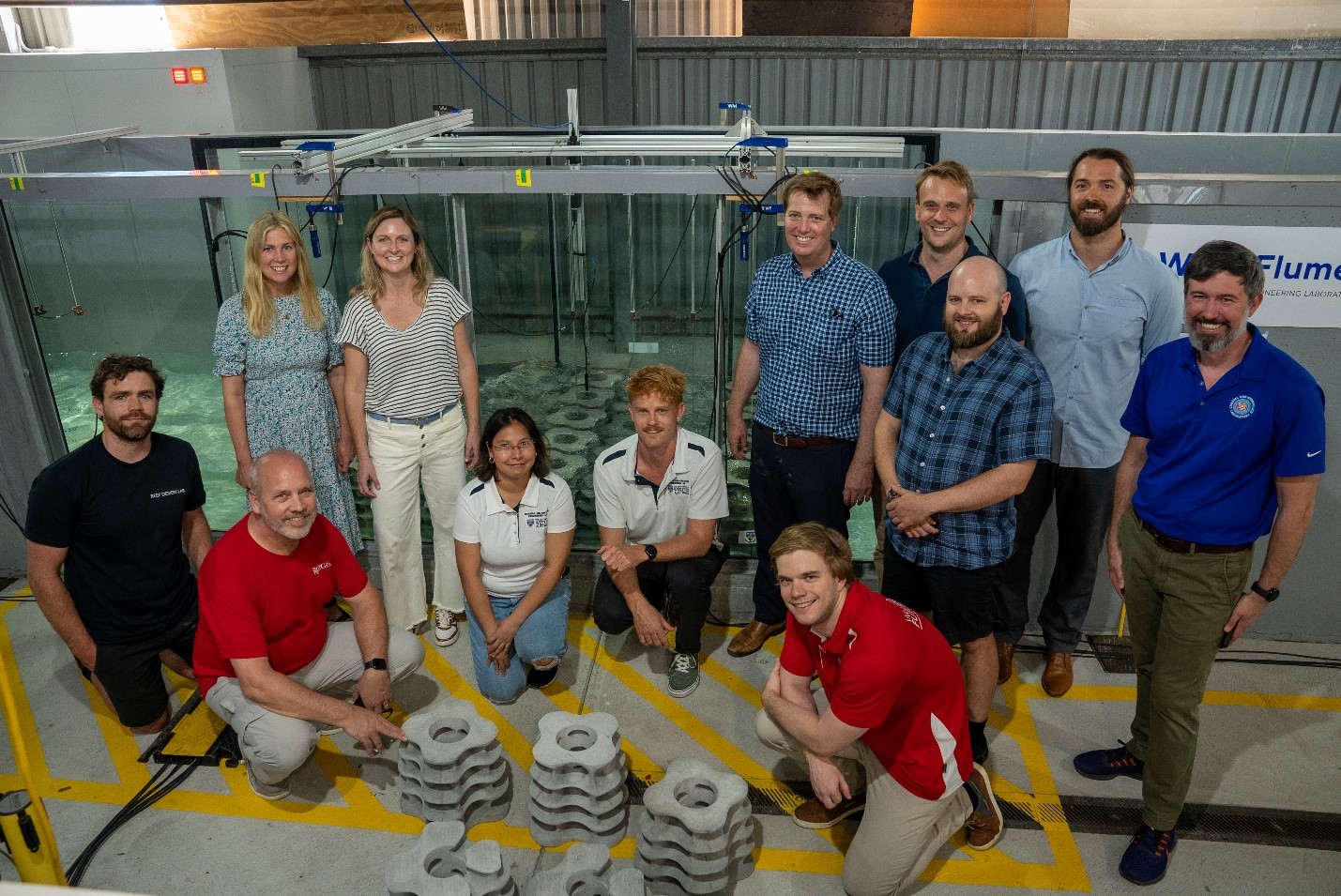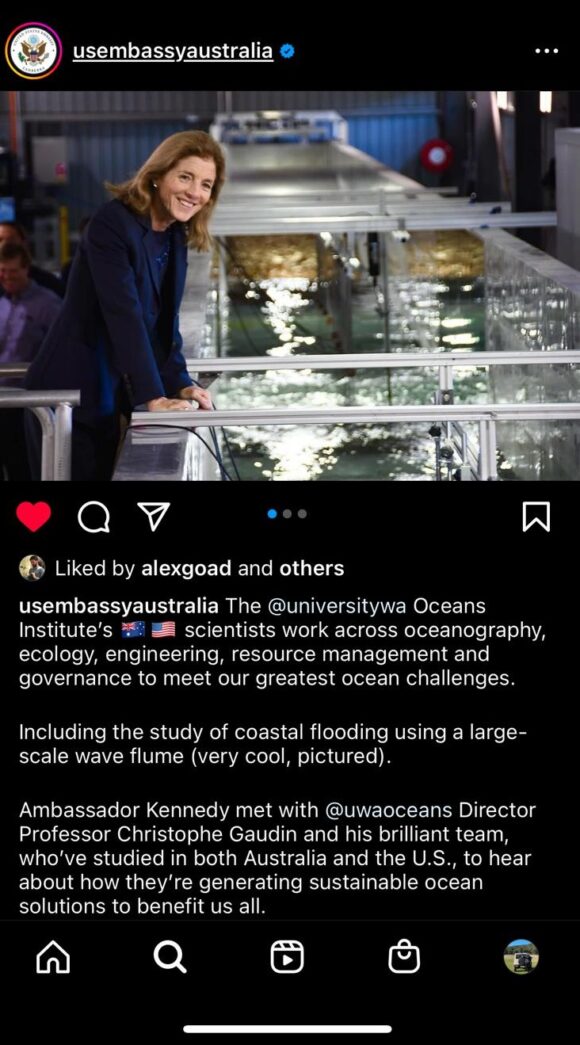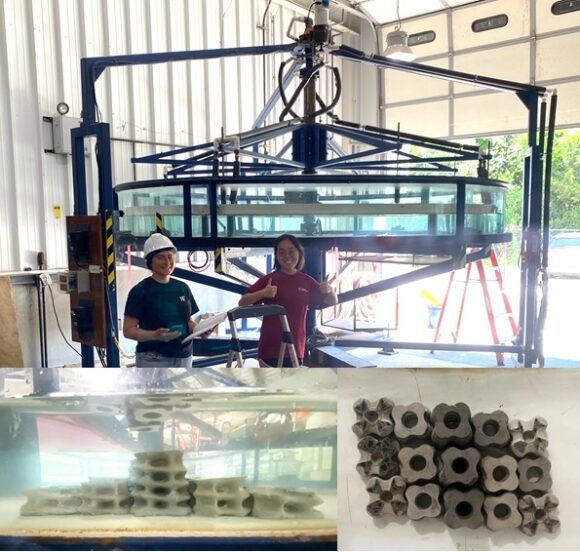
Pictured at left (in red shirt), Rutgers professor David Bushek, who directs the Haskin Shellfish Research Lab, and University of Central Florida Associate Professor Kelly Kibler (standing, second from left) with partners from Reef Design Lab, the University of Western Australia, the University of Melbourne and the U.S. Army Corps of Engineers. Courtesy of Dave Bushek.
The Rutgers-led Defense Advanced Research Projects Agency (DARPA) project—awarded $12.6 million last fall to develop an artificial reef ecosystem to help project coastlines from storm damage, flooding and erosion—recently conducted laboratory testing of modular oyster reef-mimicking structures for eventual installation in the Gulf Coast.

The modules created by Reef Design Lab in Melbourne, Australia, are specially designed by the team to maximize oyster recruitment. Courtesy of Dave Bushek.
The multi-institution project, “Reefense: A Mosaic Oyster Habitat (MOH) for Coastal Defense,” consists of three different teams comprising multiple institutions that are charged with developing resilient coastlines based upon oysters and corals, and the protective reef structures they build. The Rutgers-led team is focusing on a shellfish reef, while the two other teams, led by the University of Miami and University of Hawaii, will work with corals.
The project consists of three phases that include iterations of designing, implementing and monitoring the structures.
 Under Phase One, David Bushek, director of the Haskin Shellfish Research Lab (HSRL) and overall project lead, and an international team of scientists and partners met at the University of Western Australia (UWA) to conduct testing of the modular oyster reef structure. A large wave tank at UWA was used to test and demonstrate that the modules the team has designed to support an oyster reef breakwater can provide more than 70% wave attenuation at the eventual installation site near Panama City, FL.
Under Phase One, David Bushek, director of the Haskin Shellfish Research Lab (HSRL) and overall project lead, and an international team of scientists and partners met at the University of Western Australia (UWA) to conduct testing of the modular oyster reef structure. A large wave tank at UWA was used to test and demonstrate that the modules the team has designed to support an oyster reef breakwater can provide more than 70% wave attenuation at the eventual installation site near Panama City, FL.
U.S. Ambassador to Australia Caroline Kennedy stopped by to see the testing by this international collaboration. The successful outcome of the testing at UWA moves the project to the U.S. Army Corps facility in Vicksburg, MS, where final successful testing means that the first of two 50-meter reef installations, which are specially designed to maximize oyster recruitment, can be implemented in the East Bay of St. Andrews Bay, near Panama City in the Florida Panhandle. The oyster reef team is scheduled to implement the first structure during Phase Two in Spring 2024.
Complimentary testing at the Rutgers Aquaculture Innovation Center in Cape May, NJ, is currently examining oyster settlement and attachment to 1/10th scale models in an annular flume.

HSRL Field Researcher Jenny Shinn and 2023 RIOS Intern Nina Coli (USC) prepare to test oyster larval settlement to scaled modules in the Rutgers AIC annular flume.
Additional work led by Ximing Guo, Distinguished Professor, is applying genomic selection to improve disease resistance and growth rates in stocks of oysters native to the project site following methods developed to improve oysters in Delaware Bay and the northeast.
Professor Kelly Kibler from UCF, along with colleagues from Mississippi State and WSP, will be monitoring the pre- and post-implementation of the oyster reef structure and assessing how the reef and habitat mosaic influence sediment transport near the shoreline, important especially to a state like Florida that is vulnerable to climate change impacts and rising sea level.
Rutgers has a long history of expertise in oyster development, from Julius Nelson in 1888 to today’s cutting-edge research on disease, genetics and population dynamics by professors Bushek, Guo and Daphne Munroe of HSRL. That extensive research portfolio has been combined with expertise in materials sciences and civil engineering at Rutgers School of Engineering to serve the DARPA-funded project, which aims to develop comprehensive, enduring solutions in the northern Gulf of Mexico, the Pacific and the Caribbean/Atlantic regions.

